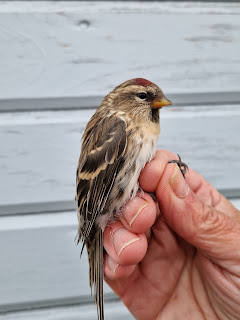A fab phyllosc
A brief review of the day to start with. Quite a good start but the wind increased and had to furl the nets about 10am. So we decided to visit a known site for Common Crane, which was successful and then a drove slowly looking for Great Grey Shrike and Northern Hawk Owl. No shrikes but we did see a Hawk Owl which gave brief but conclusive binocular views but unfortunately it flew off before we could get the telescopes on it. We went back for lunch and at 2pm we reopened the nets after which we again had lots of birds, especially Redpoll (again), but also a super little phyllosc (leaf warbler) see later.
For now we would try to give you some idea of the variation in Redpoll that we have been banging on about, so here is a bit of a gallery of plumage types.
This is perhaps the least attractive stage, which is a juvenile bird recently having left the nest as shown by the speckled breast and head with no red showing yet.
This is a slightly older juvenile which has moulted out some of the speckled feathers on the breast giving it a much cleaner appearance and moulted in the red feathers on the cap. This is probably an early/ first brood bird.
One of the species we think are particularly attractive is the Brambling, which is a close relative of the Chaffinch, but only breeds in Northern Latitudes. We are catching quite a few but this adult male is particularly attractive.
This shows the beautiful black head wings and tail contrasting with the orange shoulder and breast and brilliant white belly.

However, most birders will recognise the brilliant white rump patch which stands out as the bird flies away.
Now to the bird in the title of todays post. Phylloscopus warblers are some of the smallest birds in Europe, the commonest 2 of which in the UK are the Willow Warbler and the Chiffchaff. In northern latitudes right across from Scandinavia to the pacific there is another warbler which is doing particularly well and expanding its range. This is the Yellow-browned Warbler which are currently on the move and should be arriving in the UK anytime soon. We caught one this afternoon and as you can see, it is quite distinctive with two pale wing bars and a pronounced pale stripe over the eye.
This was the first YBW to be caught at this site which gives it extra significance as a bird currently extending its range throughout Europe- let’s hope for more in the next couple of days.
The forecast for tomorrow seems ok, and we will report again tomorrow evening.











Comments
Post a Comment